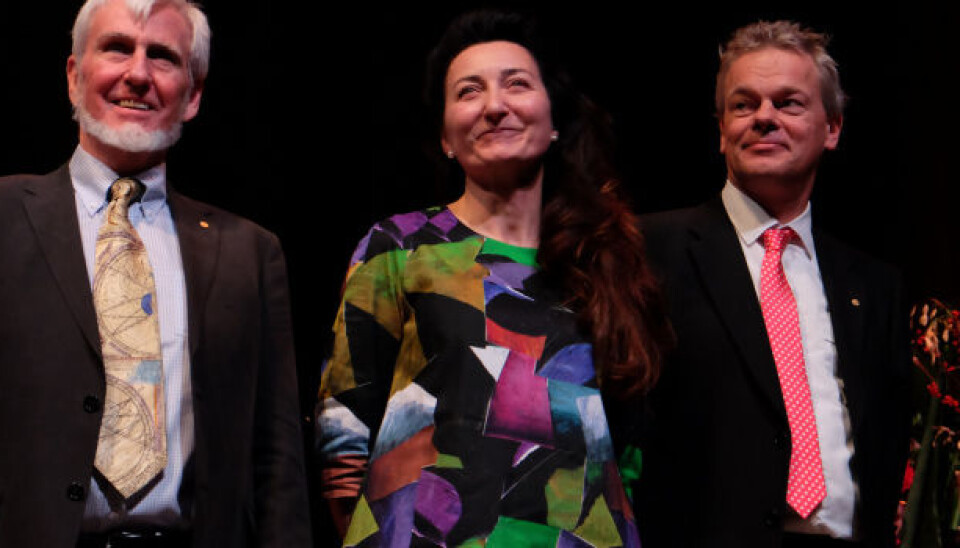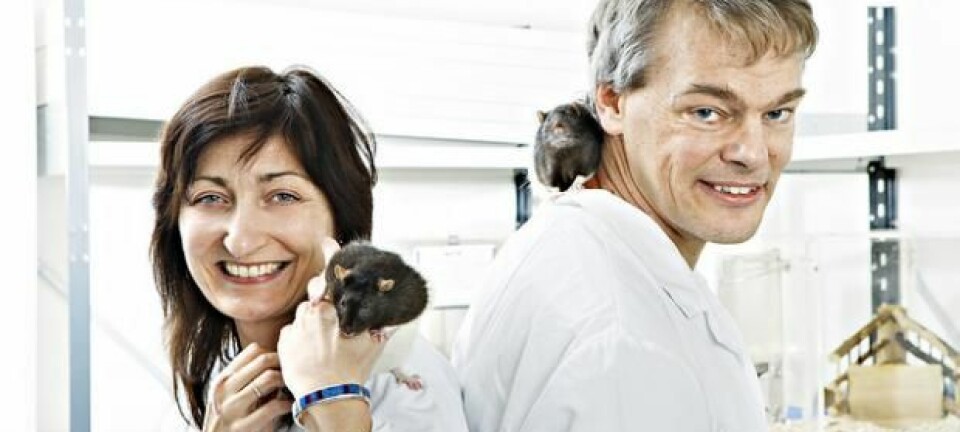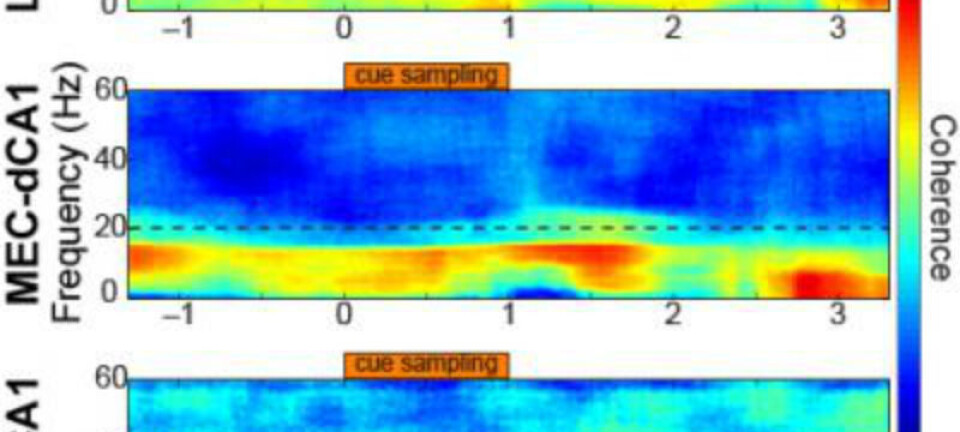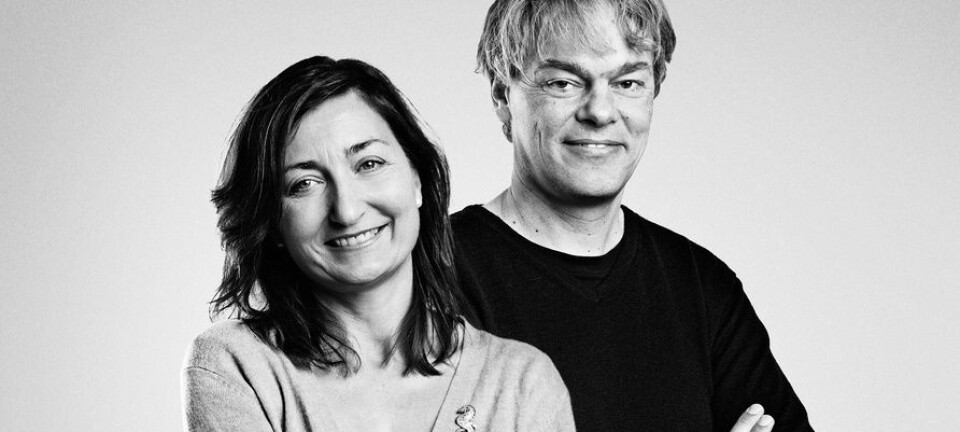An article from Norwegian SciTech News at NTNU

Nobel lectures touch on central discoveries and tantalizing findings
2014 NOBEL PRIZE: Nobel Laureates and neuroscientists May-Britt and Edvard Moser described how they made their prize-winning discovery in their Nobel lectures on Sunday 7 December. They also gave the audience a tantalizing glimpse into new findings, including the existence of speed cells in the brain, and how odours and memory are linked.
Denne artikkelen er over ti år gammel og kan inneholde utdatert informasjon.
The big screen in the Karolinska Institutet hall in Stockholm behind Nobel Laureate May-Britt Moser showed a picture of a very determined mouse on a platform. Below lay an enticing treat, a biscuit nearly the same size as the animal itself.
“I want to show you a nice relaxed mouse who is struggling with a problem like we do in science,” Moser said. “What I hope you will see is that science is the field where you can make the impossible possible.”
As Edvard Grieg’s “In the Hall of the Mountain King” played in the background, the audience watched the mouse lift the biscuit and try to hop up on its platform with the prize. For nearly a minute it failed. And then, it sat for a second on the platform, planning for one last assault – and managed to haul the biscuit up to its platform in the end.
“This is a normal day in the lab for all scientists,” Moser said as the mouse struggled. “And then you think about it… so then you get the prize.”
Moser and her husband and colleague Edvard Moser were awarded the 2014 Nobel Prize in Physiology or Medicine with their former mentor John O’Keefe. The Mosers studied briefly with O’Keefe at his lab at University College London in 1996 before establishing their own laboratory at the Norwegian University of Science and Technology, where they have been ever since. They now head the university’s Kavli Institute for Systems Neuroscience and the Centre for Neural Computation.
The Nobel Committee awarded the Mosers and O’Keefe the Nobel Prize “for their discoveries of cells that constitute a positioning system in the brain.” While O’Keefe was recognized for his discovery of place cells in 1971, the Mosers were recognized for their 2005 discovery of grid cells, and for their subsequent research that showed how place and grid cells make it possible to determine position and to navigate.
Looking for place cell signals
Grid cells are neurons that act like a GPS in the brain, and are found deep inside the organ, far from any direct inputs from the senses in an area called the entorhinal cortex. In his Nobel Lecture on Sunday, laureate Edvard Moser explained how the pair and three of their graduate students came to find the grid cells.
Moser said he and May-Britt were inspired by O’Keefe’s discovery of place cells. Place cells are neurons in the hippocampus, a C-shaped structure deep in the middle of the brain, that fire when an animal is in a specific place. That makes them distinctive, Edvard Moser said, because “they have a clear correlation and connection to the outside world,” even though these cells are buried far away from where information about the outside world comes into the brain. This curiosity about place cells brought the Mosers and O’Keefe together when the Mosers did a brief post-doctoral stint with O’Keefe in 1996.
When the Mosers left O’Keefe that same year to start their own lab at NTNU, they were fascinated by a specific question: “How is the place signal generated so far away from sensory inputs?” Moser said Sunday.
They decided to try to answer their question by figuring out where in the brain the signals to the place cells came from. They measured activity in place cells in the hippocampus, but only after they had shut down a part of the hippocampus that they believed sends signals to the place cells. Much to their surprise, the place cells continued to function the way they were supposed to – meaning that the signals to the place cells had to come from somewhere else.
“OK, where does it come from?” Edvard Moser said. “It could come from direct inputs that he (O’Keefe) had not explored. If so, then it would make sense to go one step ‘up’ in the brain, into the entorhinal cortex.”
The entorhinal cortex has the strongest input to the area of the hippocampus where the place cells are found.
A bigger box lets the pattern emerge
The Mosers began recording activity in the entorhinal cortex of rats as the animals wandered around in a box looking for chocolate treats. They soon began to see that the neurons fired in a regular pattern. There were lots of firing areas, Edvard Moser said, but they were distinct and discrete.
“Not only were there multiple fields, they were regularly spaced. But we didn’t understand the regularity quite yet,” he said.
The researchers then let the rats wander around in a larger box, which finally allowed them to see a pattern in the way that the neurons fired.
“The firing fields formed a grid that covered the entire space available to the animal,” Edvard Moser said. “We called them grid cells. You can see the hexagonal pattern (of cell firing) that overlies the activity map (which shows where the rat physically went in its box).”
Grid cells help the brain navigate in space because they give the brain information it needs about distances in the environment, he said.
The other exciting thing about grid cells, Moser said, “is that this pattern is obviously generated in the brain itself. There is no hexagonal pattern in the sensory input to the brain. So this provides us an opportunity to understand how such patterns are made.”
The Mosers ultimately hope that by mapping the brain’s circuitry and understanding how the brain does intricate tasks, like navigating through space, that they will someday be able to figure out how complex thoughts, such as memory, arise.
Orienting the grid and prisms in the brain
A Nobel Prize lecture is more than just recounting past findings. It is also a chance for the researchers to show where their research is headed in the years ahead.
Edvard Moser reported on findings that will be published in Nature magazine next year on how the grid in the brain is oriented along the six cardinal axes of the local environment and separated by 60 degrees, but offset from the main cardinal axes by as much as 7.5 degrees. This makes the grids asymmetric compared to the walls of the room, he said.
The researchers are not certain as to why this is, but the finding suggests that “the grid is developed and maintained by properties that try to make the activity patterns along the walls as dissimilar as possible,” he said.
He also described a new technique that researchers were using to understand the fine scale topography of the grid map. The researchers are able to peer into the brains of their living research subjects using tiny prisms and an optical technique that uses fluorescent calcium imaging.
Speed cells, Duplo memories and gingerbread smells
May-Britt Moser described unpublished research that suggests the brain has speed cells that work with grid cells to help the grid cells know when to be active and when to be silent, she said.
“Is there a speedometer in us?” she asked. “Maybe.”
She also discussed how the memory of an object in a rat’s box – in this case, a Duplo toy – was recorded for as long as 11 days after the object was moved and then removed.
Another study that the group is working with has trained rats to associate a smell with a place. The rat was able to do this with an accuracy of 85 per cent, meaning the rat “can retrieve a place with an odour,” May-Britt Moser said.
To illustrate the powerful ability of smells to bring back memories, she showed a “gingerbread man” video that the university commissioned.
“Odour is an extremely good retrieval cue,” she said, and quoted from Marcel Proust’s “Remembrance of Things Past”, “where he said, ‘The smell and taste of things remain poised for a long time, like souls ready to remind us, waiting and hoping for their moment.’ So that you can use odours and taste to retrieve memories.”
She concluded by briefly discussing findings that will be published in the Proceedings of the National Academy of Sciences of the United States on 8 December that show that rats were able to make statistically significantly different maps for 11 rooms that were only slightly different.
“Not only can they keep these different maps separate, they can do this after just one trial,” she said. “This is very important for episodic memory.”
The lecture ended with a 2:17 video made in conjunction with musicians from NTNU’s widely recognized jazz programme. The video shows the NTNU musicians improvising a jazz poem over a Norwegian folk tune. The poem is based on the Mosers’ research.



































